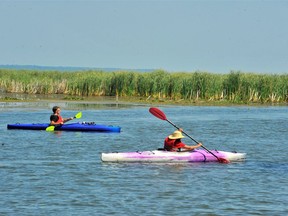Battle against phragmites seeing some victory at Long Point

Article content
Long-legged wading birds have returned to the Big Creek Marsh, as have kayakers along the shoreline on the opposite side of the Long Point Causeway in Long Point Bay.
More important, open water and distant horizons are visible from the road allowance for the first time in many years.
It’s a return to normal that feels unusual due to long years of encroachment by phragmites, an invasive species that threatened to turn the Long Point Biosophere Reserve into a dense, tall- reed monoculture.
“We’re seeing a resurgence in native vegetation and a regeneration of wildlife habitat,” Brett Norman, invasive species program manager for the Nature Conservancy of Canada and a contact person for the Long Point Phragmites Action Alliance, said this week.
Getting the upper hand on phragmites has been a multi-year effort. Once wildlife biologists and others with an interest in wetland habitat sounded the alarm more than five years ago, knocking back the aggressive intruder has been a top priority.
To date, the phragmites alliance has treated more than 1,400 hectares of critical wetland in the Long Point area that has traditionally supported a wide variety of plant, animal, fish and bird species, Norman said. He estimates there is another 1,400 hectares to go before the job is substantially complete.
With the tall reed under control in most areas of Long Point and Turkey Point, the focus has shifted to eradicating phragmites along the banks of Big Creek. Eradication also continues in the area of Long Point along its northern exposure to Long Point Bay.
The main problem with phragmites is its density and the speed with which it spreads.
Norman said there can be as many as 200 reeds per square metre. This chokes out native vegetation while serving as a trap for land-based animals that venture into stands.
“You can imagine how impenetrable that is.”
The eradication effort began in earnest once emergency approval was granted for the spraying of the herbicide glyphosate (Roundup Custom) in wetland areas of Ontario. Several years ago, smoke billowed on the horizon south of Port Dover as dead stands of phragmites on Long Point were put to the torch.
“Phragmites is such an aggressive plant that it will always need control,” Norman said. “We want to get to the point where we can detect small patches and get to them before they spread.”
Delhi Coun. Mike Columbus, chair of the Long Point Region Conservation Authority, is proud that the LPRCA pioneered techniques used to eliminate phragmites in the 800-acre Lee Brown Marsh on Lakeshore Road, west of Port Rowan.
“The methods to control phragmites were piloted at that property and applied across the province,” said Columbus, adding the success of the approach is most evident to motorists travelling on the Long Point Causeway, between Port Rowan and Long Point.
“Two years ago, you could not see far out into the lake or the wetland because phragmites were so tall,” he said. “So, it is slowly coming under control across Norfolk and across Ontario.
“When you get phragmites thick through the marsh, wildlife can’t move.”
Postmedia is committed to maintaining a lively but civil forum for discussion. Please keep comments relevant and respectful. Comments may take up to an hour to appear on the site. You will receive an email if there is a reply to your comment, an update to a thread you follow or if a user you follow comments. Visit our Community Guidelines for more information.